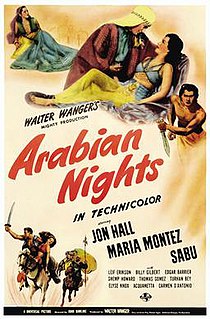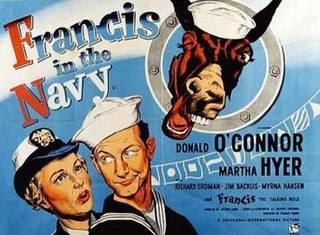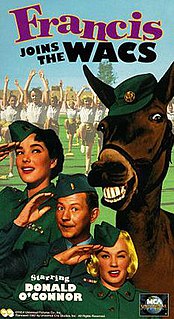
María África Gracia Vidal, known as The Queen of Technicolor, was a Dominican motion picture actress who gained fame and popularity in the 1940s as an exotic beauty starring in a series of filmed-in-Technicolor costume adventure films. Her screen image was that of a hot-blooded Latin seductress, dressed in fanciful costumes and sparkling jewels. She became so identified with these adventure epics that she became known as "The Queen of Technicolor". Over her career, Montez appeared in 26 films, 21 of which were made in North America and the last five were made in Europe.

Jon Hall was an American film actor known for playing a variety of adventurous roles, as in 1937's The Hurricane, and later when contracted to Universal Pictures, including Invisible Agent and The Invisible Man's Revenge and six movies he made with Maria Montez. He was also known to 1950s fans as the creator and star of the Ramar of the Jungle television series which ran from 1952 to 1954. Hall directed and starred in two 1960s sci-fi films in his later years, The Beach Girls and the Monster (1965) and The Navy vs. the Night Monsters (1966).

Turhan Bey was an Austrian-born actor of Turkish and Czech-Jewish origins. Turhan was active in Hollywood from 1941 to 1953. He was dubbed "The Turkish Delight" by his fans. After his return to Austria, he pursued careers as a photographer and stage director. Returning to Hollywood after a 40-year hiatus, he made several guest appearances in 1990s television series including SeaQuest DSV, Murder, She Wrote and Babylon 5 as well as a number of films. After retiring he appeared in a number of documentaries, including a German-language documentary on his life.

The Amazing Mr. X, also known as The Spiritualist, is a 1948 American horror thriller film noir directed by Bernard Vorhaus with cinematography by John Alton. The film tells the story of a phony spiritualist racket. The film is prominently featured in Alton's book on cinematography Painting with Light (1949).
To the People of the United States is a short propaganda film produced by the US Public Health Service in 1943 to warn the American GIs against syphilis. It was directed by Arthur Lubin and produced by Walter Wanger. The film was subject to protests from the Catholic Legion of Decency.

Arabian Nights is a 1942 adventure film directed by John Rawlins and starring Sabu, Maria Montez, Jon Hall and Leif Erickson. The film is derived from The Book of One Thousand and One Nights but owes more to the imagination of Universal Pictures than the original Arabian stories. Unlike other films in the genre, it features no monsters or supernatural elements.

Francis in the Navy is a 1955 American black-and-white comedy film from Universal-International, produced by Stanley Rubin and directed by Arthur Lubin. The film stars Donald O'Connor and Martha Hyer, and marked the first credited film role of Clint Eastwood. The distinctive voice of Francis is a voice-over by actor Chill Wills.

Rhubarb is a 1951 film adapted from the 1946 novel Rhubarb by humorist H. Allen Smith. Directed by Arthur Lubin, the screwball noir comedy stars the cat Orangey along with Jan Sterling and Ray Milland. Cinematography was by Lionel Lindon.

Francis is a 1950 American black-and-white comedy film from Universal-International that launched the Francis the Talking Mule film series. Francis is produced by Robert Arthur, directed by Arthur Lubin, and stars Donald O'Connor and Patricia Medina. The distinctive voice of Francis is a voice-over by actor Chill Wills.

White Savage is a 1943 American Technicolor South Seas adventure film directed by Arthur Lubin and starring Maria Montez, Jon Hall and Sabu. The film was re-released by Realart in 1948 on a double-feature with the same three stars in Cobra Woman (1944) and again in 1953, under the title White Savage Woman. It was choreographed by Lester Horton.

Ali Baba and the Forty Thieves is a 1944 adventure film directed by Arthur Lubin and starring Maria Montez and Jon Hall. The film is derived from The Book of One Thousand and One Nights but its story departs greatly from the tale of the same name and includes an actual historic event. The film is one of series of "exotic" tales released by Universal during the war years; others include Cobra Woman, Arabian Nights and White Savage.

Francis Covers the Big Town is a 1953 American black-and-white comedy film from Universal-International, produced by Leonard Goldstein, directed by Arthur Lubin, that stars Donald O'Connor, Yvette Duguay, and Gene Lockhart. The distinctive voice of Francis is a voice-over by actor Chill Wills.

Francis Joins the WACS is a 1954 American black-and-white comedy film from Universal-International, produced by Ted Richmond, directed by Arthur Lubin, that stars Donald O'Connor, Julie Adams, ZaSu Pitts, Mamie Van Doren, and Chill Wills in two roles, including the distinctive voice of Francis in voice-over.

Lady Godiva of Coventry is a 1955 American Technicolor historical drama film, directed by Arthur Lubin. It starred Maureen O'Hara in the title role. Alec Harford, the English actor who portrayed Tom the Tailor, died eight months before the film's release.

Delightfully Dangerous is a 1945 American musical film directed by Arthur Lubin showcasing teenage singer Jane Powell—in her second film on loan out to United Artists from MGM—and orchestra leader Morton Gould. The working titles of this film were Cinderella Goes to War, Reaching for the Stars and High Among the Stars. It was Frank Tashlin's first writing credit on a live action feature film.

Tangier is a 1946 black-and-white thriller film set in the international city of Tangier, Morocco that was directed by George Waggner and filmed on Universal's backlot. It was one of the last Universal Pictures films before it merged into Universal-International in July 1946.
Sudan is a 1945 American Technicolor adventure film directed by John Rawlins and starring Maria Montez, Jon Hall and Turhan Bey.

Bowery to Broadway is a 1944 American film starring Maria Montez, Jack Oakie, and Susanna Foster. Donald O'Connor and Peggy Ryan also had a small specialty act, and it was the only film they were in together where they didn't have a name or character.

Gypsy Wildcat is a 1944 Technicolor adventure film directed by Roy William Neil starring Maria Montez, Jon Hall and Peter Coe. It was co-written by James M. Cain.
The San Francisco Docks is a 1940 film directed by Arthur Lubin and starring Burgess Meredith, Barry Fitzgerald, and Irene Hervey.

















